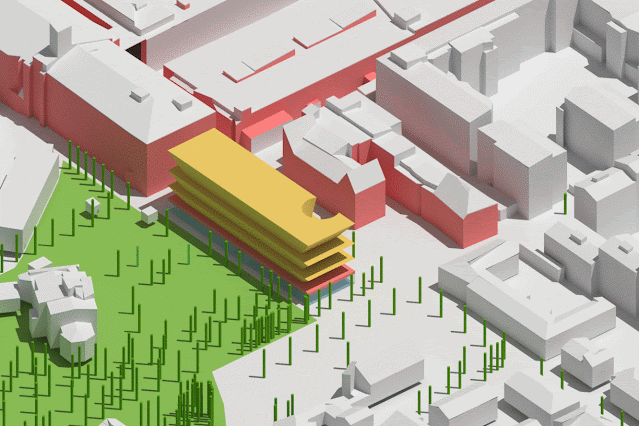
Team: Irgen Salianji, Liana Sofiadi
Visualizations: Pavlos Ventouris
Status: Competition project
Location: Tampere, Finland
Program: Museum, public functions and landscaping
Area: 4.965m2
Upon careful study of the city of
Tampere, it became obvious the central role that the industrial heritage plays
for the identity of the city. As a result the new museum is perceived as an
extension of the Finlayson Factory, with its geometry and materiality
pre-defined. However, there was a need to add up more qualities and excitement to
the project, and relate it more profoundly to the context. The idea was that
the new museum should be radically integrated
in the context on the basis of its concept, volume and materiality. The ‘radically’
of a grand gesture that affects the urban functionality and the character of
the building. The surrounding buildings and the city’s new masterplan that turns
Kuninkaankatu Street in one of the
main pedestrian and cyclist arteries connecting the central square to Särkänniemi,
was taken into account.
As a result, a diagonal axis was drawn starting on the side of
the Finlayson Palace and ending at the intersection of Kuninkaankatu and Finlaysoninkatustreets.
This axis splits the museum site in two parts. This diagonal cut achieves firstly the visual connection between the
industrial complex and the neo-classical Finlayson Palace, keeping the architectural
dialogue on. More importantly, it offers the chanceto rethink the building
location. Stepping back from the site’s western edge, the new museum is compactly
placed on the east part of the site. The rest is kept free for the park and the
city. This profound urban gesture
creates visual connections, paths and openness, while it reinforces
the project’s urban and architectural identity.
This axis also generates a border,
a green zone on the opposite part of the site, where a small-scale
‘neighbourhood plaza’ is created. This square acts as the Western welcoming gate
of the whole Finlayson complex. Therefore, the parking entrance and a public
space are also neatly and discretely located there, along the existing
building.
One of the main design objectives
is the building to refer to its industrial
context. The museum acts as the extended end of the Finlayson Factory. Therefore,
the closer to the factory, the more solid and massive it gets. On the other
side, the openness towards the city and the park influences also the form and
materiality of the building. It can be seen as a wooden box, solid on the one
end, dissolving slowly towards its other end, when reaching and referring to
the openness and the park. There it becomes light and transparent. Similarly
the red-brickshell, a reference to
the industrial character, dissolves into an intangible glass façade. The glass ending of the building welcomes green and
urban views, and the framing of the
Finlayson Palace.
Following its
form, the programme of the building is divided into public and private. The public part of the programme is placed
within the transparent part of the building, the atrium. The aim is to
activate the park and the neighbourhood by placing the public functions on
the ground floor behind glass. However, some ‘back of house’ functions are also
placed strategically in public view. The aim is to set a museum-alarm on for the pedestrians
and offer a glimpse of the operational museum functions.
The moment one enters the museum,
the shop, the multifunctional and workshop space, the café, and the info-ticket
points are already in sight. A panoramic
ramp situated in the atrium, and two elevators, bring the visitor to the
entrance point of three levels, where the exhibitions are placed.
There is a vertical ‘back-bone’ on the east side of the museum. It houses
the staff and artwork elevators, the (second) escape stairs, the toilets, and a
part of the mechanical and electrical installations. Attached to the back-bone are the loading, packing, settling and personnel
spaces on the ground floor, the staff workshop, multifunctional and technical
spaces on the underground floor, and last but not least, the artwork storage on
the highest and safest level.
The exhibition space is the
semi-public zone of the programme. Entering and exiting the gallery space is
possible for the public only through one gate per floor. It was a conscious decision
in order to ensure the access control. However, the routing in the galleries
could be set up to be circular, or via a main central space and smaller spaces
around it, or any other scenario that could serve efficiently the curator’s
intentions. In order to preserve the highest possible levels of flexibility, two loading bearing
systems were configured; firstly, a grid of CLT columns that forms a central, grand
opening and long narrow spaces on the sides; secondly, a dense grid of timber structural
beams on the ceiling, where a secondary bearing system could be mounted on.
This combination offers a wide range of possibilities for space unification or
fragmentation. There is sufficient storage space within the galleries for these
modular units to be stored.
The atrium serves as an aerial
exhibition space. Large-scale, contemporary exhibitions could be hung from the
20m-height ceiling and act as an ever changing museum logo. The main functions of packing,
settling and loading take place on the ground floor, where there is straight
connection via elevators to the exhibition spaces. Each exhibition level could
be easily isolated without influencing the function of the museum. Large scale
artworks could be inserted into the gallery space through the exterior openings
on each level, or as a secondary alternative through the opening glass façade
of the atrium.
The main structure of the
building is made of wood, in combination with the two concrete cores. It
consists of a grid of columns supporting the solid part and cantilevering the
column-free atrium. The wood is used as the main construction material,
selected to reduce the construction cost. The intention behind this choice was
a sustainability and circularity driven
design objective. The wood is a local material, easily purchased, able to be
re-used, and environmentally friendly.
The wood presides over the
interior of the museum creating a warm atmosphere. The interior atrium facade
unfolds like a wooden ribbon, which provides the interior design with
continuity and a vertical aesthetic. The furnishings of the communal spaces are
made also by wood. On the contrary, the wooden element in the galleries is limited
to the floors and beams. White plasterboard panels supported by a steel
framework clad the interior walls. To give the exhibitions a more uniform
atmosphere, Barrisol light ceilings are applied between the wooden beams.
Discover more from reviewer4you.com
Subscribe to get the latest posts to your email.






















